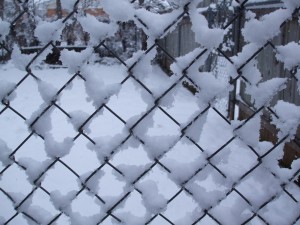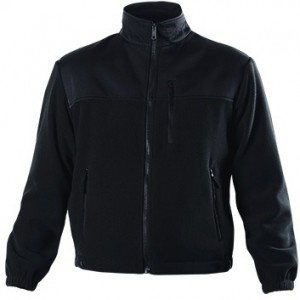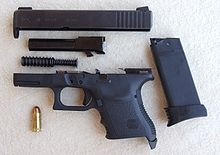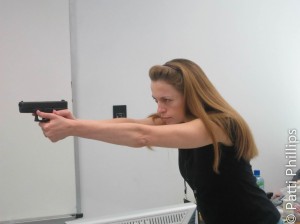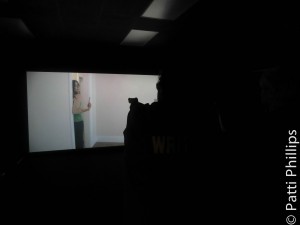Kerrian’s Notebook, p. 102 “Do you need firearms training?”

Do you own a handgun?
Do you know when to use it?
Can you take care of it?
Do you know how to use it?
These are not dumb questions to ask, because not everyone is knowledgeable about firearms, not even the ones they have in their own houses. Sometimes people buy handguns in reaction to a nearby shooting, but don’t take the time to learn about the firearm they have plopped down good money for. Sometimes one spouse has purchased the gun(s) and the other spouse is not familiar or comfortable with handling it (them).
Luckily, there are licensed, NRA sanctioned, firearms training facilities all across the country where a person can attend classes that teach the laws governing the use of firearms. The classes also cover safety, as well as proficiency, in handling a firearm.
In the USA, you must have a permit to legally purchase a handgun. You fill out a form at the gun shop, and in about a week, after the background check has been completed, you can actually purchase the gun.
If you need to obtain a concealed/carry permit, you must attend a class that includes:
- information about the gun laws,
- definitions of what is meant by lethal force,
- safe care and handling of a handgun,
- a written test,
- a handgun proficiency test.
If you meet all the requirements, then a stricter background check is run and in 4-6 weeks, the permit may be issued.
You need to know the laws in your state for owning and operating your firearm.
Not all states have the same laws about gun ownership. Some states allow open carrying, some allow concealed carrying, some allow properly licensed handgun owners to cross state lines with their guns, some don’t. Violation of these laws in any of these situations can land you in jail. And, by the way, ignorance of the law is not an excuse to avoid jail time or hefty fines.
There are legal definitions about when (and where) you are allowed to use your gun in self-defense and they vary somewhat from state to state. Ya can’t just go shootin’ your gun off in public. That will land you in jail everywhere.
Even if you have the proper credentials and concealed/carry permits, there are some places where you absolutely cannot take your gun. After a deadly shooting in a health care facility in North Carolina a few years ago, the laws were changed to bar handguns for everyone visiting private health care facilities except for law enforcement personnel. Some restaurants allow handguns, but if liquor is served, the law is different. A training class will point out the most recent changes in the law for a dozen different public settings – parks, bars, parades, etc.
How does one decide when to use a gun for self-defense?
Ask yourself whether firing it is an appropriate use of lethal force, because make no mistake, if the bullet leaves the gun, it can kill somebody.
Think before firing. There are legal ramifications to your decisions. The law requires certain legal hurdles to be met before a shooting can be justified.
Is it reasonable to shoot this person?
If the person is your size or larger, as fit as you or stronger, is threatening you with serious bodily harm, you are sure that walking away will not stop the threat, and if the police won’t get there in time, then you may be within your rights to shoot – but not always.
Is it proportional to what has already happened?
If talking the situation over has not worked, or if the other person has escalated the violence in the situation, if you are being robbed, if you are being beaten, or if you are being threatened with a gun, then you may be within your rights to shoot – but not always.
Is it necessary to shoot this person?
The danger for harm to yourself must be immediate – that is, if you don’t take a shot right then, it will be too late. You may be within your rights to shoot – but not always.
You do not have the right to shoot someone else “just ‘cause they had it coming.”
In every court case where a shooting is involved, when the phrase ‘reasonable force’ is used, the prosecution and the defense alike are looking quite seriously at what led up to the actual shooting – who did what to whom and why.
There is more to owning a gun than buying it and sticking it in a drawer.
Future posts will deal with loading your handgun safely without shooting yourself in the face or foot, proper storage of your firearm, as well as caring for your firearm so that it will fire properly when it’s needed.
*photos taken by Patti Phillips at Freedom Firearms Training, in Carthage, NC.
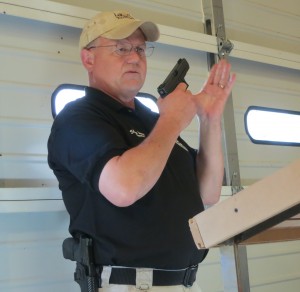
Many thanks to Steve Jones and his staff for allowing me to visit during one of his concealed/carry permit classes.
Steve Jones is an experienced NRA firearms instructor and is the owner/operator of Freedom Firearms Training.
Kerrian’s Notebook, p. 102 “Do you need firearms training?” Read More »

